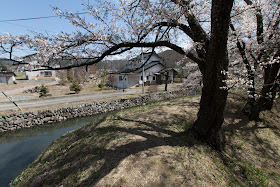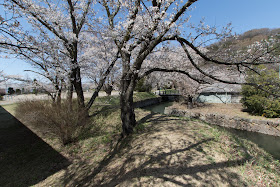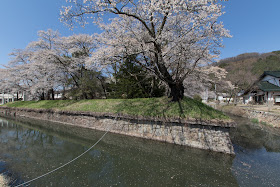Tatsuoka Castle
-Western style fortress at deep inland built by progressive lord-
Overview
Name: Tatsuoka castle (Tatsuoka-jo)
Alias: Tanokuchi Jinya (Tanokuchi Jinya castle)
Place: Taguchi Saku city, Nagano
Location: 36.19640953230309, 138.50299494246764
Type: Flat Castle
Built: 1863
Remnants: Part of hall building, gate (moved), stone walls and water moats
Title: 100 more famous Japanese castles
Tatsuoka castle (龍岡城) is located at the south part of Saku city, the one places at the east edge of Nagano prefecture. Tatsuoka area is a place where a mountainous road from Kai province (Yamanashi prefecture) comes to the Sakudaira plain, and Tomioka Kaido road, a detour route of Nakasendo Road toward Kozuke province (Gunma prefecture) passes near the castle. This area is a deep inland area and near the castle "a mathematically most distant place from seashore in Japan" locates.
Tatsuoka castle was built by Norikata Matsudaira (1839-1910, later Yuzuru Ogyu) in 1863, at the last period of Edo era. Norikata was born as the lord of Ogyu Matsudaira clan, which was the branch family of Matsudaira clan produced Ieyasu Tokugawa (1543-1616) who established Edo Shogunate. Ogyu Matsudaira clan at first reside at Ogyu castle, a mountain castle at the northwest part of Toyota city (Aichi prefecture).
In 1590, Ogyu Matsudaira clan moved to Kanto region along with their master Ieyasu Tokugawa, and became the lord in Kozuke country (Gunma prefecture). Later Ogyu Matsudaira clan was favorably treated by Edo Shogunate as a relative of Ieyasu, and descendants became the lords at Iwamura Castle (Gifu prefecture), Funai castle (Oita prefecture) and Okutono residence (Aichi prefecture).
Ancestor of Norikata became the Ogyu area, their native place, and later built their residence at Okutono area, the north part of Okazaki city (Aichi prefecture) and became Okutono domain. Later Okutono domain achieved another territory at Saku region far distant from Okutono domain.
After the arrival of Matthew Perry (1794-1858), an American admiral to Japan and opening of the nation to western countries, Japan faced advanced knowledge of Western world and also fear of invasion. Among such situaion, Norikata became Obangashira, a commander of troops of Shogunate in 1863, only at 24 years old.
Norikata liked study from youth and western knowledge, then he decided to build a western style fortress in Saku area. It is said that he wanted to avoid Okazaki area where direct attack of foreign country was expected, and at that time his Saku territory prospered by the production of silkworm cocoon.
Tatsuoka castle is one of only two pentagon shaped western style fortress along with Goryokaku (Hakodate city). Total size of the castle is about 200 meter long square, and stands at the north of small river. At the five edge of the star there were the basements of cannon, and the gate was built at north and east center of the line. Whole castle was surrounded by water moat, and residence buildings were built inside the castle.
As Okutono domain was a small domain and being built as residence, defense ability of the castle was not so high. Water moat is narrow as only five meter width, and due the its compact size and large dwelling area the central area does not have sufficient depth from the edge which is key to the western fortress. The wall of the castle is low, and the central area is easily shot by cannon from next hill. Different from Goryokaku which expected actual battle, this castle was an prototype.
Being evaluated his knowledge on Western world, Norikata later promoted to Rojyu (minister) and Rikugun Sousai (Commander in Chief of Shogunate army) at the final point of Edo era. But when 15th Shogun Yoshinobu Tokugawa (1837-1913) returned his government to Emperor Meiji in 1867, Norikata retired from that position and supported Meiji new government.
In the Meiji era Norikata became the representative of House of the Lords, and introduced prize system to Japan. Norikata also established Hakuaisha along with Tsunetami Sano (1823-1902), which later became Japan Red Cross.
Tatsuoka castle was abolished at the time of Meiji revolution, and castle site was used as a field. Later castle site became the ground of elementary school, and dining room of the residence still remains at the site. Other than that some building and gates were moved, and half of the wall and water moats still remain surrounding the school. Progressive western fortress unbecoming to the peaceful mountainous area shows the progressive mind of the lord and tension at the last decade of Edo Shogunate.
20 minutes walk from JR East Yatsugatake-Kogen line Usuda station or Tatsuokajyo station. 30 minutes drive from Joshinetsu Jidoshado Expressway Saku interchange.
Ogyu Castle -Combination of huge rocks and stone walls-
Goryokaku -Western fortress used by short-lived new republic-
Type: Flat Castle
Built: 1863
Remnants: Part of hall building, gate (moved), stone walls and water moats
Title: 100 more famous Japanese castles
Brief History
Tatsuoka castle (龍岡城) is located at the south part of Saku city, the one places at the east edge of Nagano prefecture. Tatsuoka area is a place where a mountainous road from Kai province (Yamanashi prefecture) comes to the Sakudaira plain, and Tomioka Kaido road, a detour route of Nakasendo Road toward Kozuke province (Gunma prefecture) passes near the castle. This area is a deep inland area and near the castle "a mathematically most distant place from seashore in Japan" locates.
Origin of Ogyu Matsudaira clan
Tatsuoka castle was built by Norikata Matsudaira (1839-1910, later Yuzuru Ogyu) in 1863, at the last period of Edo era. Norikata was born as the lord of Ogyu Matsudaira clan, which was the branch family of Matsudaira clan produced Ieyasu Tokugawa (1543-1616) who established Edo Shogunate. Ogyu Matsudaira clan at first reside at Ogyu castle, a mountain castle at the northwest part of Toyota city (Aichi prefecture).
In 1590, Ogyu Matsudaira clan moved to Kanto region along with their master Ieyasu Tokugawa, and became the lord in Kozuke country (Gunma prefecture). Later Ogyu Matsudaira clan was favorably treated by Edo Shogunate as a relative of Ieyasu, and descendants became the lords at Iwamura Castle (Gifu prefecture), Funai castle (Oita prefecture) and Okutono residence (Aichi prefecture).
Ancestor of Norikata became the Ogyu area, their native place, and later built their residence at Okutono area, the north part of Okazaki city (Aichi prefecture) and became Okutono domain. Later Okutono domain achieved another territory at Saku region far distant from Okutono domain.
Western style fortress built by progressive lord
After the arrival of Matthew Perry (1794-1858), an American admiral to Japan and opening of the nation to western countries, Japan faced advanced knowledge of Western world and also fear of invasion. Among such situaion, Norikata became Obangashira, a commander of troops of Shogunate in 1863, only at 24 years old.
Norikata liked study from youth and western knowledge, then he decided to build a western style fortress in Saku area. It is said that he wanted to avoid Okazaki area where direct attack of foreign country was expected, and at that time his Saku territory prospered by the production of silkworm cocoon.
Tatsuoka castle is one of only two pentagon shaped western style fortress along with Goryokaku (Hakodate city). Total size of the castle is about 200 meter long square, and stands at the north of small river. At the five edge of the star there were the basements of cannon, and the gate was built at north and east center of the line. Whole castle was surrounded by water moat, and residence buildings were built inside the castle.
As Okutono domain was a small domain and being built as residence, defense ability of the castle was not so high. Water moat is narrow as only five meter width, and due the its compact size and large dwelling area the central area does not have sufficient depth from the edge which is key to the western fortress. The wall of the castle is low, and the central area is easily shot by cannon from next hill. Different from Goryokaku which expected actual battle, this castle was an prototype.
Afterward of the lord and castle
Being evaluated his knowledge on Western world, Norikata later promoted to Rojyu (minister) and Rikugun Sousai (Commander in Chief of Shogunate army) at the final point of Edo era. But when 15th Shogun Yoshinobu Tokugawa (1837-1913) returned his government to Emperor Meiji in 1867, Norikata retired from that position and supported Meiji new government.
In the Meiji era Norikata became the representative of House of the Lords, and introduced prize system to Japan. Norikata also established Hakuaisha along with Tsunetami Sano (1823-1902), which later became Japan Red Cross.
Tatsuoka castle was abolished at the time of Meiji revolution, and castle site was used as a field. Later castle site became the ground of elementary school, and dining room of the residence still remains at the site. Other than that some building and gates were moved, and half of the wall and water moats still remain surrounding the school. Progressive western fortress unbecoming to the peaceful mountainous area shows the progressive mind of the lord and tension at the last decade of Edo Shogunate.
Access
20 minutes walk from JR East Yatsugatake-Kogen line Usuda station or Tatsuokajyo station. 30 minutes drive from Joshinetsu Jidoshado Expressway Saku interchange.
Related Castles
Ogyu Castle -Combination of huge rocks and stone walls-
Goryokaku -Western fortress used by short-lived new republic-









































































































No comments:
Post a Comment